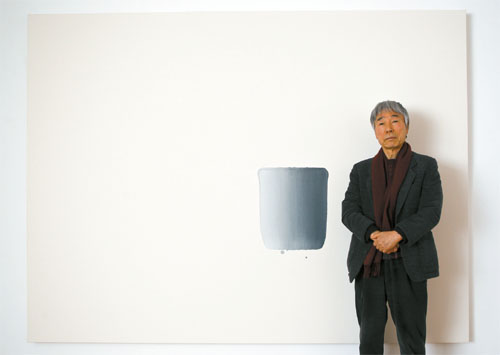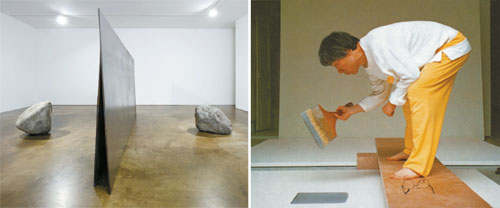Lee Ufan still fighting the good fight

Korean-born artist Lee Ufan stands in front of one of his paintings at the Kukje Gallery in Samcheong-dong, central Seoul. By Cho Yong-chul
“Why do I do art? It would be a lie to say that I do it to empty my mind,” renowned Korean-born artist Lee Ufan, 75, said in a recent interview. “I do it because of overwhelming desire.”
Lee’s busy schedule, which includes trips around the world for exhibitions in Japan, France and Germany, does not grant him much time for interviews.
But he took some time on a recent afternoon to sit down with the JoongAng Sunday at the Kukje Gallery in Samcheong-dong, central Seoul. Luckily, the artist was more than generous with his time.
What was supposed to be an hour-long interview turned into four hours of in-depth discussion.
Lee got things started by giving advice to young Korean artists, urging them to follow their dreams, to go to unseen places and to fight for what they believe in.
“There is always competition within art,” Lee said. “We must fight to win.”
Lee started his fight when he moved to Japan in the summer of 1956 while studying at Seoul National University’s College of Fine Arts.
Now he is about to become the third Asian artist to have his work exhibited at the Solomon R. Guggenheim Museum, following Paik Nam-june (2000) and Cai Guo-Qiang (2008). The exhibition is slated to run from June 24 to Sept. 28 at the iconic museum in New York.

Lee Ufan works on a painting in his “Dialogue” series, above right. His “Relatum-Dialogue,” appears above left. Provided by Kukje Gallery and JoongAng Sunday
Q. When did you start getting into art?
A. I have a sense of inferiority in art. When I was very young, my mentor Hwang Kyun-yong, whose pen name is Dong-cho, recognized my talents and abilities in poetry, calligraphy and art. But he encouraged me to become a politician or scholar, saying that men shouldn’t get involved in art. Because of that, I didn’t sense the value or importance of things that can be seen.
What happened next?
I’ve been thinking for some years about how to rationalize my artistic thoughts. I’ve realized that art is not just about seeing what’s in front of you. It is a concept that we can sense when looking at the bigger picture. Being able to see further than what lies in front of us introduces us to a totally different idea.
What led you to go to Japan?
During my summer vacation after my first year in college, my father told me to take some traditional Korean medicine to my uncle, who lived in Japan at the time.
While I was there, my uncle offered to let me stay. I liked the idea of moving to Japan back then because I wasn’t content with my enrollment in the College of Fine Arts. I therefore made the decision to transfer to Nihon University, where I earned a degree in philosophy.
Why did you major in philosophy?
I had actually wanted to study literature ever since I was young. I had to study philosophy before going into literature, but learning a new language and studying literature at the same time was too difficult. I was also interested in political science, but I ultimately chose philosophy.
What made you lose interest in political science?
While I was in college, I believed it was necessary for North and South Korea to reunite, and I also protested against South Korea’s military regime.
But as Korea’s gross national product rose in value, and as friends and family wrote about how life in Korea was getting better and better, I was embarrassed about my opposing political views and lost interest in politics. After that, I began associating with artists.
What is the Mono-ha movement?
The Mono-ha movement was used to criticize Western modernism. In this sense, the 1960s was an important era all throughout the world. Around the same time, movements like Arte Povera (meaning minimal art; this was an Italian movement in 1967), and the college student rights movement (a Japanese student movement from 1968 to 1969) began to appear. Mono-ha is simply a way to connect things that are seen and not seen and things that are on the outside and on the inside. This form of art may look very simple, but it pushes us to think about unseen notions, such as the concept, location and time behind a work of art.
Did the Mono-ha movement begin after you started to lose interest in politics?
The Mono-ha movement began at the end of the 1960s through a newly introduced form of art in Japan called “kinetic art.” Kinetic art was an artistic technique used to create an optical illusion.
People were uncertain about these new techniques and movements because they criticized reality. Because things that seemed to exist did not exist, and things were proved to be neither right nor wrong, society started to question reality. Thus, I believe that there is more to art than simply drawing and painting. Art should intertwine with society and history.
How did the word “Mono-ha” come about?
There are still unanswered questions, but the word contains a cynical meaning of unskilled artists who create artworks just by gathering random objects and putting them together.
Could you explain more about the “unseen” notions you mentioned earlier?
This is a concept that needs some explanation, but just as with Surrealism and Dadaism, Mono-ha was not created by accident. It was created through the flow of history and careful artistic research.
The general public may not ask what a piece of art is, but as professionals, we need to be able to answer the “why” behind the artwork instead of the “what” in order to understand the things that are unseen.
It is actually good to feel out of place and lost when looking at such artwork because this type of art is supposed to provide a hint about what lies ahead of our time. I keep my distance from the public, but not because I’m ignoring the public. My main concern is at what point in art history I will be located.
Have you faced discrimination in Japan?
I’ve been discriminated against for being an artist without a degree in fine arts. I’ve had to fight in order to survive.
The Korean people treated me as a Japanese person, the Japanese regarded me as a Korean, and the Europeans ignored me for being an Asian artist. I was always the odd man out, but I never gave up. If I had thought about giving up, I would not have survived.
Because I have lived such a life, I can tell the young artists out there to confront the bare existence of what is actually before them. This concept is also a very important one in modern philosophy. It is ultimately our responsibility to accept the people who stand before us. I believe I have overcome this concept in my life.
You have written a lot of books that convey your influence.
Yes, I have. Writing is one of the best tools to polish the thoughts that come to mind. I believe that writing down one’s thoughts with pen and paper for 20 to 30 minutes a day is an essential workout.
Do you still continue to fight today?
I continue to fight for three things. First, I fight against modernism and imperialism, and second, I fight against nationalism and regionalism. Lastly, I fight for what I believe in.
I continue to fight today because I have not yet won the battle. As I fight, I hope to move away from the ideas of society whether it is Korean, Japanese or European. After all, I don’t care which society I fit into. I am just Lee Ufan.
PROFILE
Lee Ufan
Born in Korea in 1936
* Education
While studying at Seoul National University’s College of Fine Arts, Lee transferred to Nihon University in Tokyo where he earned a degree in philosophy.
* Major exhibitions
- 1971 Paris Biennale
- “Lee Ufan: Resonance,” a solo exhibition at the 2007 Venice Biennale
- Exhibition at the Yokohama Museum of Art in 2005
* Publications in English
“The Art of Encounter” (2007), an anthology
By Jung Hyung-mo [estyle@joongang.co.kr]










with the Korea JoongAng Daily
To write comments, please log in to one of the accounts.
Standards Board Policy (0/250자)